 |

 Seasoned travelers know how much a noble museum can transform any city into a much-desired destination. The art museums of Philadelphia offer a fascinating alternative to the well-known institutions of New York and Washington. In fact very few North American cities offer as rich and exciting an opportunity to view the full range and quality of American and European and world art as does Philadelphia.
Seasoned travelers know how much a noble museum can transform any city into a much-desired destination. The art museums of Philadelphia offer a fascinating alternative to the well-known institutions of New York and Washington. In fact very few North American cities offer as rich and exciting an opportunity to view the full range and quality of American and European and world art as does Philadelphia.
Day-trippers take notice: the Philly tourism board advises "You just can't do it in a day". This is especially true when one considers visiting the Pennsylvania Academy of the Fine Arts, the Rodin Museum, the Philadelphia Museum of Art, the University of Pennsylvania Museum of Archaeology and Anthropology and, just a few miles outside the city, the Barnes Foundation in Merion.
With all this in mind, a friend and I decided to make a weekend visit to the city of Benjamin Franklin and Rocky Balboa. We boarded the Amtrak train from Washington DC on a Thursday morning and arrived at the 30th Street Station three hours later. The late summer day was so delightfully dulcet that we decided to walk the fifteen blocks to our hotel. The Courtyard Marriott is right in the heart of the downtown core, adjacent to the City Hall. As we walked toward that distinguished structure we admired the way Philadelphia combines the old and the new in its architecture. We were not disappointed by our room, which afforded us a spectacular view of the upper levels of the edifice, which is one of the finest examples of French Second Empire architecture in the nation.
Our first stop after settling in was the medical school of Thomas Jefferson University, a few blocks away. Several notable paintings by Thomas Eakins are housed there. The finest realist painter America has ever produced, Eakins was a lifelong student of the human body. In his early years he took courses in anatomy at this school. Thus there are several portraits of his teachers here, in particular one done in tribute to a Dr. Gross 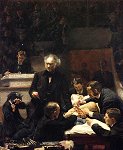 , which must rank as the best group portrait and medical history painting of the 19th century. , which must rank as the best group portrait and medical history painting of the 19th century.
The thirty-one-year-old Eakins depicted a heroic physician presiding over a difficult operation while performing the multiple tasks of instructing students and training assistants. The monumental composition is based on Rembrandt's Anatomy Lesson of Dr. Tulp 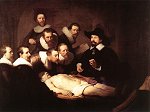 . It still has the power to shock with the bold matter of factness and immediacy of the action as the horrified reaction of the sole female in the painting, the patient's mother, indicates. But it is the calm authority, forceful energy and keen intellect of the surgeon that inspires in the viewer a genuine feeling of awe at what human effort can produce at its maximum levels. Over in the extensive Eakins collection at the Philadelphia Museum of Art, there is a later and related work called The Agnew Clinic . It still has the power to shock with the bold matter of factness and immediacy of the action as the horrified reaction of the sole female in the painting, the patient's mother, indicates. But it is the calm authority, forceful energy and keen intellect of the surgeon that inspires in the viewer a genuine feeling of awe at what human effort can produce at its maximum levels. Over in the extensive Eakins collection at the Philadelphia Museum of Art, there is a later and related work called The Agnew Clinic 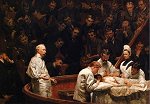 which, though somewhat less adventurous than this painting, has a more assured feel and makes for an absorbing comparison. which, though somewhat less adventurous than this painting, has a more assured feel and makes for an absorbing comparison.
Next on the agenda was the nation's first art museum and school of fine art, the Pennsylvania Academy of the Fine Arts. Founded in 1805 by Charles Willson Peale, this is the nation's oldest continuously operating museum and school of fine arts. Frank Furness and George Hewitt designed the landmark Gothic Victorian building in 1876. This is where Eakins taught, and many of the great American painters and sculptors studied here. Thus the collection contains major works from every era and every artist in American art, making it arguably the finest such collection of painting and sculpture in the nation.
This summer the Academy is renovating this wonderful old building and getting ready to open its new extension wing next door. In January it will be celebrating its 200th anniversary with In Full View American Painting and Sculpture (1720-2005). This will be the most extensive exhibit of the collection ever presented including pieces from every era of American art.
I was lucky to catch a preview of some of the pieces which will be on display and would not want to miss the opportunity to walk these halls again and see Benjamin West's Penn's Treaty with the Indians 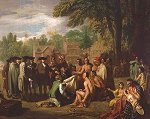 (1771-72) Charles Willson Peale's The Artist in His Museum (1771-72) Charles Willson Peale's The Artist in His Museum 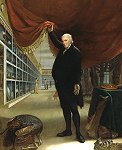 (1822), Winslow Homer's The Fox Hunt (1822), Winslow Homer's The Fox Hunt  (1893) and Henry Ossawa Tanner's The Annunciation (1893) and Henry Ossawa Tanner's The Annunciation 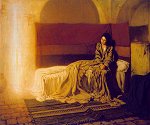 . .
That evening we made our pilgrimage to the historic district around Independence Hall. This is where the Declaration of Independence was written in 1776 and the Constitution was drafted in the summer of 1787. It was a quiet night with only one tour group inspecting the grounds. I was especially struck by how much truly revolutionary political thought emerged from this one square mile of rather humble red brick Georgian buildings.
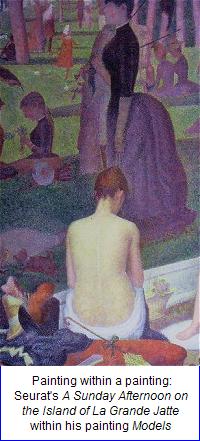 The next morning we headed for the train station for our trip to the Barnes Foundation located about ten minutes outside the city, in the very upscale suburb of Merion. There has been a lot of talk of late of the Barnes moving out of Merion so I was glad to signs reading "The Barnes Belongs in Merion" on the lawns of the neighborhood houses as we walked from the train station to the Foundation.
The next morning we headed for the train station for our trip to the Barnes Foundation located about ten minutes outside the city, in the very upscale suburb of Merion. There has been a lot of talk of late of the Barnes moving out of Merion so I was glad to signs reading "The Barnes Belongs in Merion" on the lawns of the neighborhood houses as we walked from the train station to the Foundation.
Albert Barnes made a fortune in the patent medicine business and turned to art collecting during the period when it was still possible to acquire impressionist and post impressionists paintings by the lot. It helped that his was also very savvy businessman who benefited greatly from his associations with such artists as William Glackens, who scouted paintings for him in Europe.
There are dozens of superlative paintings by Renoir and Paul Cézanne and Henri Matisse here. Most of the works in this collection are not that well known despite the great fame of the painters who produced them. Works like Matisse's The Joy of Life (Le bonheur de vivre) 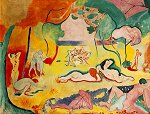 , Cézanne's Great Bathers (Les grandes baigneuses) , Cézanne's Great Bathers (Les grandes baigneuses) 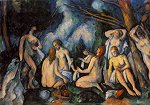 and Card Players and Girl and Card Players and Girl 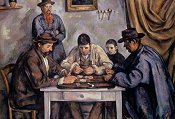 and Georges Seurat's Models and Georges Seurat's Models 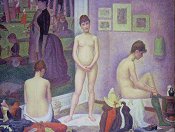 are infrequently seen outside Merion since, with the exception of the legendary tour ten years ago, the Barnes never sends its works out on loan and rarely even allows them to be reproduced. These considerations make a pilgrimage to the Barnes a must for anyone who loves these artists. are infrequently seen outside Merion since, with the exception of the legendary tour ten years ago, the Barnes never sends its works out on loan and rarely even allows them to be reproduced. These considerations make a pilgrimage to the Barnes a must for anyone who loves these artists.
After years of reading that the gallery was "notorious" for its hostility to visitors I was amazed how easy it was to make reservations and how welcoming the staff was. But the biggest revelation was how enjoyable it is to view these works in the way that Barnes required by the terms of his will. The collection is still hung in such a way as to invite the visitor to make his or her own connections between artists unencumbered by the stylist labels and other intrusive didactic devices which most museum employ.
Thus paintings from different centuries (Titian and Rubens and Renoir) are hung together in the eighteen galleries. Since your ticket gets you in for the entire day you are invited to spend as long as you like making your own comparisons. Most visitors seem energized by this opportunity for self-study. And when you need a respite from the demands of appreciating such a fine collection of artworks, the twelve acres of gardens offer a refreshing change of view. (Note - Barnes took a lot of ridicule for his "method" but one should remember that the great American philosopher John Dewey worked closely with Barnes for a time and acknowledged his indebtedness in the preface to his seminal work on aesthetics, Art as Experience.)
After three hours we were satiated by all this largely Gallic genius. We headed back to the city with time to spare to refresh and recharge our batteries before heading out to the Philadelphia Museum of Art, which is open late on Friday nights. One our way toward this great institution we noted the Rodin Museum just a few block away and made a note to visit that notable repository of the 20th century's greatest sculptor on our next trip.
The PMA is a vast honey colored temple rising majestically at the end of Benjamin Franklin Parkway. A skeptical artist once grumbled about the expense of building the "Greek garage" implying doubts that its vastness would ever be filled. But thanks to an outpouring of gifts and judicious purchases over the years, the Museum now brims with treasures, installed with rare character.
One of the greatest pleasures of this museum is its many period room and installations including a reception hall from the palace of a Chinese nobleman of the Ming dynasty and Ceremonial Teahouse from the 18th century. My favorite was the medieval cloister with a Romanesque fountain but the Grand Salon from a French chateau and the drawing room from the Landsdown House in London, which is an archetypical example of the work of the architect Robert Adams, transfixed my friend. We were both disappointed that Turner's magnificent Burning of the Houses of Lords and Commons 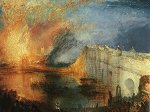 was on tour but were delighted to discover the small room filled with the oil sketches of John Constable. was on tour but were delighted to discover the small room filled with the oil sketches of John Constable.
The museum's galleries are studded throughout with memorable works. Especially strong in the Northern European paintings, the collection contains some of the best examples of this school in America. It is remarkable to see a Jan van Eyck outside the great collections of Europe or Western Russia, but here in Philadelphia one can see Saint Francis Receiving the Stigmata 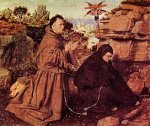 . In this work, less than five inches in height, van Eyck represents the world in miniature with his characteristic completeness. There are flowers, crags, boulders, and pebbles; a river and a spring; hills, clouds, and birds; a city with men on foot and on horseback around its gates; and yet other cities in the distance. This diminutive work is truly a mighty tour de force, which can easily be overlooked. So if you go be sure to ask the guard where it is located . In this work, less than five inches in height, van Eyck represents the world in miniature with his characteristic completeness. There are flowers, crags, boulders, and pebbles; a river and a spring; hills, clouds, and birds; a city with men on foot and on horseback around its gates; and yet other cities in the distance. This diminutive work is truly a mighty tour de force, which can easily be overlooked. So if you go be sure to ask the guard where it is located
Another room contains Rubens' Prometheus Bound 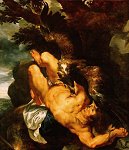 . The eight foot high Rubens is especially eye catching. Prometheus was the demigod who stole the secret of fire from the gods and gave it to man. To punish him Zeus, the ruler of the gods, bound him to a rock where he was tortured for all time by an eagle that fed on his liver. Rubens considered this one of his best paintings and kept in his private collection for years. Fortunately for us, the centuries would see this and many other pieces travel from private collections across the Atlantic to the New World and to today's Philadelphia, where all who have a chance to spend time in the City of Brotherly Love will be in a position to see it. . The eight foot high Rubens is especially eye catching. Prometheus was the demigod who stole the secret of fire from the gods and gave it to man. To punish him Zeus, the ruler of the gods, bound him to a rock where he was tortured for all time by an eagle that fed on his liver. Rubens considered this one of his best paintings and kept in his private collection for years. Fortunately for us, the centuries would see this and many other pieces travel from private collections across the Atlantic to the New World and to today's Philadelphia, where all who have a chance to spend time in the City of Brotherly Love will be in a position to see it.
I could go on and on about the wonders contained in the PMA. Instead let me urge you to make plans to visit Philadelphia soon. And I hope I have convinced you that "You just can't do it in a day" In fact we didn't have time to tour the University of Pennsylvania Museum of Archaeology and Anthropology, which houses the contents of the Royal Tombs of Ur in ancient Iraq dating to 2650-2550 BC. But we will next time.
Artcyclopedia entries for artists mentioned in the text:
Museums mentioned in the text:
|
Past Articles
2004
Featured on the Web: Understanding Islamic Art and its Influence, by Joseph Phelan
Independence Day: Sanford R. Gifford and the Hudson River School, by Joseph Phelan
The "Look" of Mel Gibson's The Passion of the Christ, by Joseph Phelan
The Importance of Being Odd: Nerdrum's Challenge to Modernism, by Paul A. Cantor
2003
Advent Calendar 2003, narrated by Joseph Phelan
If Paintings Could Talk: Paul Johnson's Art: A New History, by Joseph Phelan
Mad Max [Max Beckmann], by Joseph Phelan
Marsden Hartley: The Return of the Native, by Joseph Phelan
Jean-Antoine Houdon: Sculptor of the Enlightenment, by Joseph Phelan
Frederic Remington's Nocturnes, by Joseph Phelan
Magnificenza! Titian and Michelangelo, Manet and Velazquez, by Joseph Phelan
Masterful Leonardo and Graphic Dürer, by Joseph Phelan
Favorite Online Art Museum Features, by Joseph Phelan
Studies for Masterpieces, by John Malyon
2002
Portrait of the Artist as a Serial Killer, by Joseph Phelan
Renoir's Travelling, Bonnard's "At Home", by Joseph Phelan
The Philosopher as Hero: Raphael's The School of Athens, by Joseph Phelan
The Greatest Works of Art of Western Civilization
Celebrating Heroes; Celebrating Benjamin West, by Joseph Phelan
Chasing the Red Deer into the American Sublime (Education and the Art Museum, Part II), by Joseph Phelan
Planning Your Summer Vacation, by Joseph Phelan
Education and the Art Museum, Part I, by Joseph Phelan
Unsung Griots of American Painting, by Joseph Phelan
The British Museum COMPASS Project, interview by Joseph Phelan
Robert Hughes, Time Magazine Art Critic: Biography and Writings
2001
Software review: Le Louvre: The Virtual Visit on DVD-ROM, by Joseph Phelan
Tragedy and Triumph at Arles: Van Gogh and Gauguin, by Joseph Phelan
Her Last Bow: Sister Wendy in America, by Joseph Phelan
Love, Death and Resurrection: The Paintings of Stanley Spencer, by Joseph Phelan
Who is Rodin's Thinker?, by Joseph Phelan
Celebrations North and South, by Joseph Phelan
Rubens and his Age, by Joseph Phelan
Great Reproductions of Great Paintings
The Passion of Christ, by Joseph Phelan
Edouard Manet: Public Spaces, Private Dreams, by Joseph Phelan
Henry Moore and the British Museum: The Great Conversation, by Joseph Phelan
2000
Notorious Portraits, Part II, by John Malyon
Notorious Portraits, Part I, by John Malyon
The Other Michelangelo, by Joseph Phelan
The Art of Drawing, by Joseph Phelan
Poussin and the Heroic Landscape, by Joseph Phelan
Great Art Museums Online, by Joseph Phelan
Venetian Painting and the Rise of Landscape, by Joseph Phelan
Forbidden Visions: Mythology in Art, by Joseph Phelan
Themes in Art: The Passion of Christ, by Joseph Phelan
Web site review: Christus Rex
Web site review: National Gallery of Art, Washington, D.C., by Joseph Phelan
Online exhibit review: Inuit Art: The World Around Me, by John Malyon
Poll: Who is Producing the Most Interesting Art Today? (Results)
Poll: Who is Producing the Most Interesting Art Today? (Part II)
1999
Poll: Who is Producing the Most Interesting Art Today? (Part I)
Spotlight on The Louvre Museum
Spotlight on Impressionism
Spotlight on Optical Art
Spotlight on Animals in Art
Spotlight on Surrealism
Spotlight on Sculpture
Spotlight on Women in the Arts
Spotlight on The Golden Age of Illustration
Spotlight on Vincent van Gogh
Spotlight on Great Art
|
















